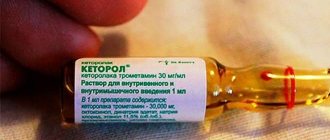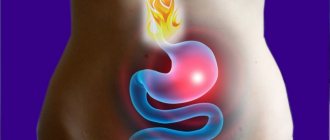pharmachologic effect
The therapeutic property of the drug is due to its pronounced antihistamine effect. It belongs to the 2nd generation drugs, due to which a longer pharmacological effect is observed. It does not affect the nervous or cardiovascular systems and is characterized by the absence of sedation.
Loratadine exhibits a complex pharmacological effect, helping to relieve itching, exudative processes and other signs of allergy. Helps reduce tissue swelling and relieve muscle spasms.
The therapeutic effect is observed an hour after taking the drug and persists throughout the day.
Analogs
Analogues of this drug, which have the same active substance as it, are: Lotharen, Alerpriv, Erolin, Clallergin, Loratadine-Teva, Clargotil, Clarisens, Claritin, Loratadine-Verte, LauraGexal, Clarifer, Clarotadine, Lomilan, Loratadine-Hemofarm.
According to a similar mechanism of action and inclusion in the same pharmacological group, analogues of the drug include: Allerfex, Semprex, Histafen, Ciel, Gifast, Telfast, Diazolin, Fexadin, Diacin, Fexofast, Dimebon, Elisey Fenkarol, Dimedroquine, Erius, Dinox, Rupafin, Dramina , Fexofenadine, Kestin, Desloratadine, Ketotifen, Dezal, Lordestin, Ezlor, Peritol, Aviamarin, Rapido, Nalorius.
What is Loratadine taken for?
An antihistamine is prescribed for the treatment of:
- Dermatitis, especially contact dermatitis.
- Rhinita.
- Allergic conditions of delayed and immediate type.
- Eczema in the chronic stage.
- Conjunctivitis.
- Insect bites.
- Urticaria in acute and chronic forms.
- Attacks of bronchial asthma.
- Hay fever.
Indications and contraindications
Indications for the drug include:
- Seasonal rhinitis;
- Year-round rhinitis;
- Quincke's edema;
- Allergic itchy rash;
- Hives;
- Hay fever;
- Conjunctivitis;
- Itching after insect bites.
The drug begins to act 30 minutes after administration. Maximum impact begins after 8-12 hours and lasts up to 24 hours. Due to this long-term effect, it is advisable to take Loratadine once a day
Loratadine is prohibited for use by pregnant and lactating women, children under 3 years of age (for tablets), children under 2 years of age (for syrup), as well as with hypersensitivity to the components of the antiallergic drug
Doctors prescribe Loratadine treatment with caution to people who have a history of pathology such as renal failure.
Side effects
As a result of neglecting the instructions for use and medical prescriptions, side effects may develop. The most common among them are:
- Dizziness and headache.
- Sleep disturbance, drowsiness or insomnia.
- Fatigue, malaise.
- Dyspeptic disorders.
- Hair loss.
- Allergic signs.
- Strong feeling of hunger.
- Changes in liver function.
In young children from 2 years of age, after using the syrup, headaches, psycho-emotional disturbances, anxiety, fatigue and increased agitation were observed.
What can be replaced
Loratadine has many drugs that are analogues of the active substance and have a similar medicinal effect.
Table: analogue drugs of Loratadine
| Name | Release forms | Active substance | Indications | Contraindications | From what age can it be used? | Cost of the drug in Russian pharmacies |
| Tsetrin | Pills. | Cetirizine. |
|
| 6+ | Packaged:
|
| Erius |
| Desloratadine. |
|
| From 6 months. | Packaged:
|
| Lomilan |
| Loratadine. | Since Loratadine and all these drugs are based on the same active ingredient, the indications and contraindications for them are identical. They are listed in the corresponding block of the article. | 2+ (for syrup) and 3+ (for tablets) | Packaged:
| |
| LauraHEXAL | Pills. | There are 10 tablets in a package - from 46 rubles. | ||||
| Clarisens |
| Packaged:
| ||||
| Claritin |
| Packaged:
| ||||
| Claridol | Pills. | There are 7 tablets in a package - from 199 rubles. |
How to take Loratadine
Adult patients and children over 12 years of age are prescribed the drug at a dose of 10 mg per day.
Persons with liver pathologies are recommended to take the drug once every two days in an amount of 10 mg or daily no more than 5 mg.
It is advisable to drink tablets and syrup 10-15 minutes before meals.
For kidney disease and the elderly, no dosage adjustment is required.
The duration of the course of therapy depends on the diagnosis and clinical picture, and is determined by the doctor.
On average, Loratadine is taken for 1-2 weeks. If there is no therapeutic effect, the course may be increased to a month.
If necessary, Loratadine can be combined with other drugs in severe allergic reactions.
Drug interactions
With simultaneous use of Loratadine with drugs that inhibit the isoenzymes CYP2D6 and CYP3A4 or are metabolized in the liver with their participation (including ketoconazole, erythromycin, quinidine, fluoxetine, cimetidine, fluconazole), a change in the plasma concentration of both substances is possible.
The effectiveness of Loratadine is reduced by inducers of microsomal oxidation (ethanol, tricyclic antidepressants, barbiturates, rifampicin, zixorin, phenytoin, phenylbutazone).
special instructions
In some cases, an antihistamine may cause a dependent sedative effect.
One of the side effects of Loratadine is drowsiness, but it does not affect driving.
If you need to test for an allergen, you should avoid taking the medication a week before the intended procedure.
The drug is based on lactose, so it is contraindicated for persons with intolerance or poor absorption of this substance.
The syrup is prescribed with caution to patients with diabetes mellitus, since refined sugar is included in the composition.
Release form and packaging
Dosage forms:
- Tablets: almost white or white, round, flat-cylindrical in shape, with a chamfer and a dividing line (10 pcs. in a blister pack, in a cardboard pack of 1, 2 or 3 packs; 10 pcs. in blisters or strips, in a cardboard pack of 1 blister or 1 strip; 10 pcs in polymer cans, 1 can in a cardboard pack; 30 pcs in a strip pack, 1 pack in a cardboard pack);
- Syrup (50 or 100 ml in dark glass bottles, 1 bottle in a cardboard box, complete with a dosing cup or spoon).
What generation is Loratadine?
Loratadine belongs to anti-allergenic drugs (generation II) and is considered one of the most popular. When compared with other drugs in this group, it benefits from its low cost and greater antihistamine activity, which is ensured due to the high level of strength of bonds with peripheral H1 type receptors.
The opinions of qualified allergists confirm the fact that the medication does not have a sedative effect, does not increase the effects of ethanol, has no cardiotoxic effect, practically does not interact with other drugs and is not addictive.
Pharmacodynamics and pharmacokinetics
Loratadine is a systemic drug with antiallergic, antiexudative and antipruritic effects. It is a blocker of H1-histamine receptors, inhibits the release of histamine and the active contractile agent leukotriene C4 from mast cells. By binding to receptors, this drug prevents the action of histamine, which causes contraction of vascular walls and smooth muscles, helps reduce capillary permeability, significantly reduces the manifestations of erythema, skin itching, inhibits exudation, relieves muscle spasms, prevents the development of tissue edema, and facilitates allergic reactions.
The therapeutic (antiallergic) effect of the drug develops in the first 30 minutes after oral administration. After 8-12 hours it reaches its maximum and continues to last throughout the day. Loratadine does not have a negative effect on the central nervous system and does not produce a sedative or anticholinergic effect.
Pharmacokinetics
Loratadine is rapidly and significantly absorbed from the gastrointestinal tract. Its maximum concentration in the blood plasma is achieved in 1–1.5 hours. For the active metabolite of this substance, desloratadine, this figure is 1.5–3.7 hours.
- Taking the drug with food increases the time to reach the maximum concentration of the active substance and desloratadine by approximately 1 hour, but does not affect the effectiveness of the drug. The maximum concentration of loratadine and desloratadine does not depend on meals.
- In patients suffering from chronic kidney disease, the maximum concentration and AUC (area under the concentration-time curve) of loratadine and its pharmacologically active metabolite are increased compared to patients with normal renal function. At the same time, the half-life values of loratadine and desloratadine in patients with renal dysfunction practically do not change.
- In patients with alcoholic liver damage, the AUC and maximum concentration of loratadine and desloratadine are increased by 2 times compared to patients with normal liver function.
- Loratadine is highly bound to plasma proteins (about 97–99%). Its metabolite desloratadine shows a moderate degree of plasma protein binding (about 73–76%).
- The metabolic process during which loratadine is converted to desloratadine involves the cytochrome P4503A4 system and, to a lesser extent, the cytochrome P4502D6 system.
- The drug is excreted in urine (approximately 40% of the oral dose) and feces (approximately 42% of the oral dose) for more than 10 days, mainly in the form of conjugated metabolites. About 27% of the oral dose is excreted through the kidneys within 24 hours after taking Loratadine. Less than 1% of the active component of the drug is excreted unchanged in the urine within 24 hours after administration.
- The bioavailability of loratadine and desloratadine is directly proportional to the dose of the drug taken.
- Studies involving adult and elderly healthy volunteers have shown that the pharmacokinetic profiles of loratadine and its metabolite remain virtually identical in both cases.
- The half-life of loratadine varies from 3 to 20 hours (average value of this parameter is 8.4 hours), and desloratadine - from 8.8 to 92 hours (average value of this parameter is 28 hours). In elderly patients, this figure is 6.7‒37 hours (average 18.2 hours) and 11‒39 hours (average 17.5 hours), respectively. With liver damage associated with alcohol abuse, the half-life increases (the exact value is determined by the severity of the disease) and remains unchanged in the presence of chronic renal failure.
- In patients with chronic renal failure, hemodialysis sessions do not have a significant effect on the pharmacokinetic parameters of loratadine and desloratadine.











